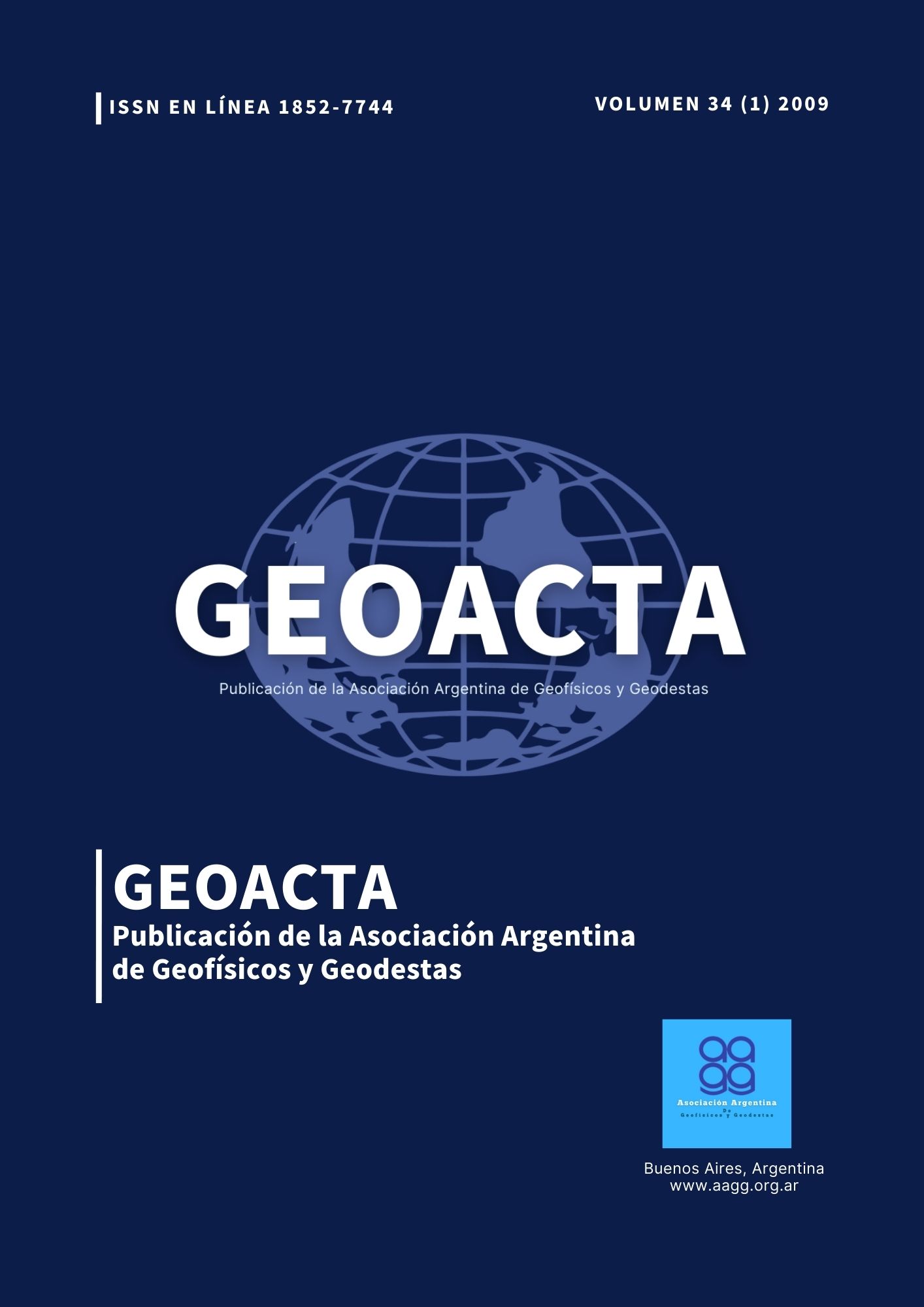Estimación de profundidades del Complejo Plutónico Navarrete mediante procesamiento gravimétrico
Keywords:
Gravimetry, Somuncurá, Granites, Structures, DepthsAbstract
A gravimetric study is presented in the northeast region of the Somuncurá massif, with the objective of analyzing the geometry and maximum depths of the Navarrete Plutonic Complex, located in the upper crust. A Bouguer anomaly map was filtered in order to separating these anomalies in regional anomaly (which should contain the effects of deep crustal features) and residual anomaly (which should contain the effects of local and near surface masses). The process used was the upward continuation method of the potential field. As a result, the west Navarrete granite formation shows a positive value of +5 mGal for gravity anomalies. On the contrary, the east Navarrete granite formation presents negative values between -5 and -10 mGal. A two dimensional power spectrum was applied to the Bouguer residual anomaly to estimate the igneous bodies’ maximum depths, with 8 km depth for east Navarrete granite and 6.5 km for west Navarrete granite.
Downloads
References
Basei, M. et al., 2002. 15° Cong. Geol. Arg., Actas, 3: 117-122.
Caminos, R., 1983. Descripción Geológica de las Hojas 39g, Cerro Tapiluke y 39h, Chipauquil, Provincia de Río Negro. Servicio Geológico Nacional, 41p (inédito).
Gupta, V.K. and N. Ramani, 1980. Some aspects regional-residual separation of gravity anomalies in a Precambrian terrain. Geophysics, v. 45, nro. 9 ,1412-1426.
Hinze, W.J., 2003. Bouguer reduction density, why 2.67. Geophysics, v. 68, 5, 1559-1560.
Hinze, W.J. et al., 2005. New standards for reducing gravity data: The North American Gravity database. Geophysics, v. 70, 4 J25-J32.
Kane, M.F., 1962. A Comprehensive System of Terrain Corrections Using a Digital Computer. Geophysics, v. 27, 4 455-462.
LaFehr, T.R., 1991. Standardization in gravity reduction. Geophysics, 56 1170-1178.
Morelli, C. et al.,1974. The International Gravity Standardization Net 1971. International Association of Geodesy, Special Publication 4.
Nagy, D., 1966. The Gravitacional Attraction of a Right Rectangular Prism. Geophysics, v. 31, nro. 2 362-371.
Pankhurst, R.J, C.W. Rapela, C.M. Fanning, M. Márquez, 2006. Gonwanide continental collision and the origin of Patagonia. Earth-Science Reviews, v.76, issues 3-4, 235-257.
Pankhurst, R.J, R. Caminos y C.W. Rapela, 1999. Problemas Geocronológicos de los Granitoides Gondwánicos de Nahuel Niyeu, Macizo Norpatagónico. XII Congreso Geológico Argentino y II Congreso de Exploración de Hidrocarburos. Actas IV 99-104.
Rapela, C.W. y E.J. Llambías, 1984. Evolución magmática y relaciones regionales de los Complejos Eruptivos de La Esperanza. Provincia de Río Negro. Asociación Geológica Argentina, Revista 40 (1): 4-25. Buenos Aires
Spector, A. and Grant, F.S., 1970. Statistical models for interpreting aeromagnetic data. Geophysics, 35:293-302
Downloads
Published
How to Cite
Issue
Section
License
Copyright (c) 2009 Flavia A. Croce, Federico Lince Klingerer, Mario E. Giménez, M. Patricia Martinez, Francisco Ruiz

This work is licensed under a Creative Commons Attribution-NonCommercial-ShareAlike 4.0 International License.
Starting in 2022 (Vol. 43 number 2) articles will be published in the journal under a Creative Commons Attribution-NonCommercial-ShareAlike 4.0 International license (CC BY-NC-SA 4.0)
According to these terms, the material can be shared (copied and redistributed in any medium or format) and adapted (remixed, transformed and created from the material another work), provided that a) the authorship and the original source of its publication (journal and URL of the work), b) is not used for commercial purposes and c) the same license terms are maintained.
Prior to this date the articles were published in the journal under a Creative Commons Attribution license (CC BY)
In both cases, the acceptance of the originals by the journal implies the non-exclusive assignment of the economic rights of the authors in favor of the editor, who allows reuse, after editing (postprint), under the license that corresponds according to the edition.
Such assignment means, on the one hand, that after its publication (postprint) in the GEOACTA Magazine of the Association of Geophysicists and Geodesists, the authors can publish their work in any language, medium and format (in such cases, it is requested that it be recorded that the material was originally published in this journal); on the other, the authorization of the authors for the work to be harvested by SEDICI, the institutional repository of the National University of La Plata, and to be disseminated in the databases that the editorial team considers appropriate to increase visibility. of the publication and its authors.
Likewise, the journal encourages the authors so that after their publication in the Journal of the Association of Geophysicists and Geodesists, they deposit their productions in other institutional and thematic repositories, under the principle that offering society scientific production and Unrestricted academic scholarship contributes to a greater exchange of global knowledge.
















